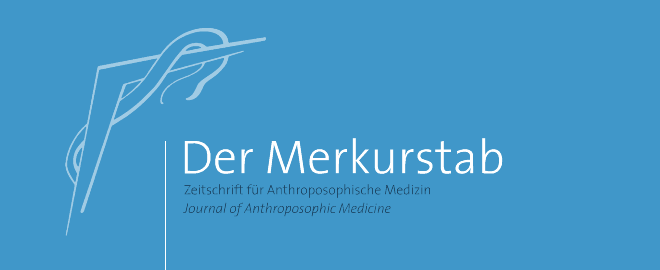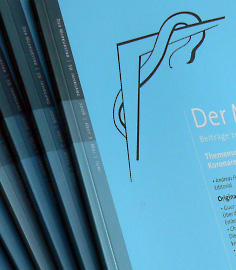
HEFT 1/2013
Der Merkurstab | Januar/Februar 2013 | 22,00 Euro (inkl. Mwst., zzgl. Versandkosten)

| Artikel | Vegetabilisierte Metalle - Pharmazeutische Grundlagen und Zubereitung der Metall-Dünger Vegetabilized metals - Basis of pharmaceutical method and preparation of metal-fertilizer |
| Autor | Wolfram Engel |
| Seiten | 04-17 |
| Volume | 66 |
Zusammenfassung
Mineral und Pflanze begegnen sich im Wurzelbereich. Die Pflanze verlebendigt fortlaufend mineralisch-tote Stoffe des Erdbodens und trägt diese bis in die Blüte hinauf. Dadurch gelangen diese unter den Einfluss der einstrahlenden Umkreiskräfte. Am Beispiel der Großen Brennnessel (Urtica dioica L.), von Gundermann (Glechoma hederacea L.) und Tabak (Nicotiana tabacum L.) wurde gezeigt, wie unterschiedliche Pflanzen die einzelnen Mineralstoffe spezifisch aufnehmen können. Das in der anthroposophischen Pharmazie neue und einmalige Herstellungsverfahren der Vegetabilisierten Metalle (Weleda) wurde von Rudolf Steiner erstmals 1921 im 7. Vortrag des zweiten Ärztekurses (GA 313) ausgeführt. In einem mit einem bestimmten Metall versetzten Boden lässt man Pflanzen wachsen, damit diese die mineralischen Metallkräfte unter Einbeziehung der in der Natur wirkenden Kräfte umformen. Dadurch, dass die mit Metall gedüngte Pflanze selber wieder als eine Art "Düngemittel" verwendet wird, "verschärft" sich die Wirkung. Die auf diese Weise hergestellten Arzneimittel, so Rudolf Steiner, seien "in einem wesentlichen Grade wirksamer" als die Arzneimittel, denen eine homöopathische Verreibung von Metallen zugrunde liegt.
Die Herstellung der Metall-Dünger wird am Beispiel des Eisens "ausgehend von Pyrit" geschildert. Die vier zugefügten Komponenten repräsentieren die am Eiweißaufbau beteiligten Elemente Sauerstoff, Schwefel, Kohlenstoff und Stickstoff. Das saure Verhalten und die Flüchtigkeit aller vier Komponenten kann als Wasserstoffqualität gesehen werden. Die Charakterisierung dieser fünf "Bausteine" des Eiweißes als Träger des Geistigen durch Rudolf Steiner im 3. Vortrag des Landwirtschaftlichen Kurses (GA 327) aufgreifend, wird ein Bogen zwischen der Vergangenheit der Metalle und deren Zukunft gespannt. Durch das Verlassen der eiweißartigen Urlebenssphäre der Lemuris erscheinen uns heute die Metalle in der Erde als "Leichname".
Pflanzensamen können als männliches Prinzip mit kosmischer Herkunft aufgefasst werden. Sie befruchten die mütterliche Erde, damit sich neues Leben entfalten kann. Auch die Metalle sind kosmischer Herkunft und tragen etwas Zukünftiges in sich. Da sie ihren Samencharakter noch nicht aus eigener Kraft zur Wirkung bringen können, tritt die Pflanze als Dienerin auf und lässt das Metall in ihrem Ätherleib aufkeimen. Die Düngerherstellung mit den eiweißverwandten Prozessen ist eine wichtige Voraussetzung, damit die Pflanze und das Metall intensiver zusammenwirken können. Dies geschieht in der Humusschicht bzw. im Kompost, die beide einen Bezug zu den lemurischen Erdenverhältnissen erkennen lassen.
Aufgrund dieses besonderen pharmazeutischen Verfahrens ergeben sich eine Reihe therapeutischer Möglichkeiten, die kurz angedeutet werden. Beachtenswert ist die zeitliche Nähe einer wesentlichen Besprechung Rudolf Steiners mit Pharmazeuten zum Thema der Vegetabilisierten Metalle (8. 2.1923), einem Vortrag Rudolf Steiners am 10. 2.1923 zur Aufnahme von Metallen durch die Pflanze (GA 348) und dem so genannten "Kästchenvortrag" am 11. 2.1923 (GA 221). Abschließend wird auf den Leitsatz "Was ist die Erde in Wirklichkeit im Makrokosmos?" (GA 26) und die dort von Rudolf Steiner beschriebene Aufgabe des Mineral- und Pflanzenreichs für die Zukunft der Erdenentwicklung geblickt.
Abstract
Minerals and plants encounter each other in the region of the roots. The plant continuously enlivens the dead mineral substances of the soil and takes them up all the way to the flower. This it exposes them to the influence of the in-streaming peripheral forces. Stinging nettle (Urtica dioica L.), ground ivy (Glechoma hedera L.) and tobacco (Nicotiana tabacum L.) serve as examples to show showing how different plants are able to take up specific minerals. The unique manufacturing process for vegetabilized metals (Weleda) first developed in anthroposophical pharmacy was first introduced by Rudolf Steiner in 1921 in the 7th lecture of Anthroposophical Spiritual Science and Medical Therapy. Plants are grown in soil treated with a particular metal. They transform the mineral metal forces by brining in the forces active in nature. The effect is enhanced by using this metal-fertilized plant itself as a kind of ‘fertilizing agent’. The medicinal products obtained in this way should according to Rudolf Steiner be considerably more effective than those made from a metal by homoeopathic trituration.
The production of the metal fertilizer is described with iron as the example, starting with pyrites. The four added components oxygen, sulphur, carbon and nitrogen represent the elements of protein synthesis. The acidity and volatility of all four components may be seen as a hydrogen quality. In the 3rd lecture of the Agriculture Course Rudolf Steiner characterized these five ‘building stones’ of protein as vehicles for the spirit; using this, an arc may be drawn from the past of the metals to their future. Following the departure from the protein-like primeval life sphere of Lemuria, the metals appear to us today as ‘corpses’ in the ground.
Plant seeds may be seen as male principles of cosmic origin. They fertilize the mother earth so that new life may unfold. Metals are also of cosmic origin and bear something of the future in them. As they are not yet able to bring their seed character into effect out of their own powers, the plant does it for them and allows the metal to germinate in its ether body. The manufacture of fertilizer with the protein-related processes is an important pre-condition for plant and metal being able to work more intensively together. This takes place in the humus layer, or compost, where a relationship to Lemurian conditions of the earth may be recognized.
This particular pharmaceutical procedure provides a number of therapeutic possibilities which are briefly mentioned. It is worth mentioning the closeness in time of a significant discussion Rudolf Steiner had with pharmacists on the subject of vegetabilized metals (8th Feb. 1923), a lecture he gave on 10th Feb. 1923 which also covered the uptake of metals through the plant (in From Comets to Cocaine) and the lecture of 11th Feb. 1923 (in Earthly Knowledge and Heavenly Wisdom). In conclusion we consider the guiding principle ‘What is the Earth in reality within the Macrocosm?’ (in Anthroposophical Leading Thoughts) and the task there described by Rudolf Steiner for the mineral and plant kingdoms in future earth evolution.
